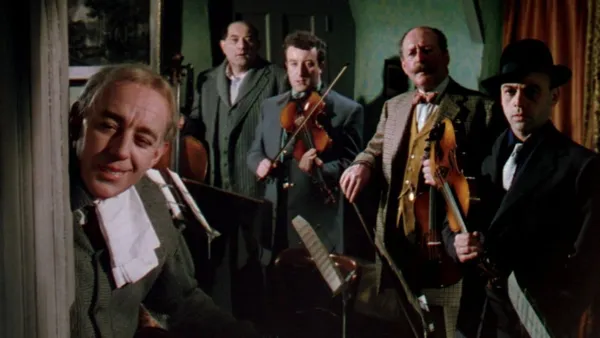Eye For Film >> Movies >> The Ladykillers (1955) Film Review

Alexander Mackendrick's deliciously dark comedy about a group of criminals, a charming old dear and a heist gone bad is celebrating its 60th birthday this year, but age hasn't diminished it. It is generally considered the last of the Ealing comedies, although a final comedy, Who Done It?, would be made a year later before the studio was bought by the BBC. It is undoubtedly one of the best. This is largely down to its shifting tone, which mixes the absurd with the dainty and the mordant.
The architecture of the film - and buildings and angles are an integral part of why it works so well - rests upon the twin pillars of Katie Johnson and Alec Guinness. Johnson plays Mrs Wilberforce, who floats through the action like a benificent but deadly iceberg, her bird-like surface fragility hiding a juggernaut of immutability. She is a lady most definitely not for turning. Guinness, meanwhile, with a false set of teeth that are at once absurd yet sinister, is Professor Marcus, drably grey and dishevelled in the face of Mrs W's pastel combinations, a mixture of failed Oxford don and conniving megalomaniac.

Then there is Mrs Wilberforce's house - built specifically by the studio, so that virtually none of the internal angles ring true. This is the Victorian era in subsidence and, from the moment Guinness sets foot over the threshhold to hire some lodgings, we know that nothing about either he or it is on the level. Mrs Wilberforce is an innocent abroad, blissfully unaware as she makes tea and chats to her parrots (Peter Sellers on vocals) that the Professor's string quintet - Major Courtney (Cecil Parker), Mr Harvey (Herbert Lom), Mr Robinson (Sellers, in his breakthrough role) and Mr Lawson (Danny Green) - are playing an LP of Boccherini while they plan a robbery. She will become an unwitting part of their plot but for all the Professor's planning, his bungling bunch will soon dig themselves into trouble and infighting. Even they - like us - will come to realise they are powerless against her innocent but deeply moral fibre.
Despite the film being shot in three-strip technicolor, and the costumes being chosen to mark the difference between the lavender-scented colour palette of Mrs W and her friends and the darker, mustier notes of the Professor's henchmen, it is light and shadow that are the real stars here. Mackendrick and cinematographer Otto Heller use the silhouette of Guinness to bring dark notes to Mrs W's doorstep and later scenes, in which members of the gang fight on a railway embankment while steam trains rush beneath them, are shot in a greying half-light. Here the colour is stripped away, so that the billowing white plumes of steam fall in stark contrast to the half-hidden figures as the end-game plays out. There is a dark, noir element to these scenes that seems to anticipate the grittier cinema to come in the next decade or so.
Mackendrick's rooms also grow dark as crimes are discussed and brighter in the presence of Mrs W - so that she sometimes seems to glow with an inner light. Her sense of dominance is never greater than one of several hallway scenes - which tend to see all the cast crushed into the space in a ways that the director exploits both for humour and threat, depending on the occcasion - when her acquaintances come to tea. Here it is she, bolstered by her flock of friends, who has the upper hand, herding both sets of characters before laying down the law with the instruction: "Simply try for one hour to behave like gentlemen."
The script by William Rose cracks along at a decent pace and though each of the characters is an archetype - from the Mid-Europe killer (Lom) to the heart-of-gold thug (Green) - Mackendrick and Rose use this to their advantage, tailoring the comic moments to our expectations.
If there is a false note, it is the barrow boy street scene with Frankie Howerd, during which Mrs W causes chaos. It feels extraneous - much neater is the setting up of Mrs W as unwitting trouble when she inadvertently makes a baby cry in one of the very first scenes - and was clearly intended as a little comic showcase for Howerd (playing Howerd, of course) as much as furthering the plot.
Do the gang represent all stratas of society, with Mrs Wilberforce as the British Empire, at once standing in the face of corruption, yet limiting and surprisingly dangerous? Perhaps. More important for a viewer though is that we like them all, on some level, and start to feel sympathy for the gang as well as a perverse glee as they begin to be picked off one by one, while the mournful train whistles blow.
Reviewed on: 01 Nov 2015


















